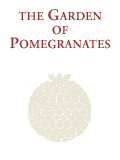THE POMEGRANATE CARPETS AND THE KABBALAH
The Hebrew word Kabbalah is used to indicate the secret tradition of Jewish mysticism, namely the philosophical and esoteric movement which began in Spain and in Provence between the 12th and 13th Centuries.
The mystics chose the term Kabbalah, (acceptance) to emphasize the fact that they were dealing with esoteric knowledge handed down to them from the past in order that they may perpetuate its understanding and dissemination.
Transmitting knowledge obtained from the past is the basis of the Kabbalah. The handing down of knowledge from generation to generation is not seen as a development of the doctrine, but rather as an action to avoid the danger of losing the most ancient and valuable teachings, because they are considered to be of divine origin.
The Spanish Kabbalah, which represents the most important form of Jewish mysticism, was a theosophical system which made use of a symbolic language which explained the nature of the divine world and its occult links with Creation. The system was set out in the Zohar, which according to modern critics was written between1280 and 1287 by the Spanish Kabbalist Moses de León de Granada, but which was attributed to the 2nd Century Rabbi Simeon bar Yohai.
Beyond human contemplation there exists God as He is in himself, namely a dynamic outpouring of unknowable force: the unchanging En Sof (Infinite). The aspects or attributes which can be discerned from God's relationship with the created world are emanations of the En Sof, configured in ten Sefirot and considered archetypes of creation the understanding of which discloses the occult dynamics of the cosmos and the earth.
In order to discover the hidden meaning behind the literal content of the Torah, the Jewish masters devised a wide range of refined tools and focused on the meaning of individual verses until they could grasp the meaning of the individual words.
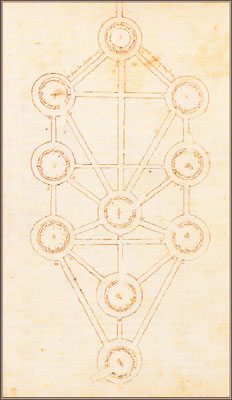 |
| Tree of Spheres |
The central theme of all the Kabbalah is the Sephirot (1). The Sephirot can be interpreted as degrees or levels through which God's power acts in the world. There are ten Sephirot, and ten is the number which represents completeness because it interprets a complete, definitive set. The ancient kabbalists believed that ten expressed the profound structure of being and was the best way the represent the entire cosmos.
The Tree of Life is an abstract and symbolic diagram comprising these ten entities arranged along three parallel vertical pillars: three on the left, three on the right, and four in the middle.
The central pillar extends above and below the other two. The Sephirot relate to major metaphysical concepts and actual levels within the Divinity. They are furthermore associated with the practical and emotional situations experienced by each of us in everyday life. The Sephirot constitute ten basic principles which are recognizable in the complex and disorderly multiplicity of human life and are capable of unifying them and endowing them with meaning and fullness. The ten Sephirot are connnected by means of twenty-two channels, of which three are horizontal, seven vertical and twelve diagonal. Each channel corresponds to one of the twenty-two letters of the Hebrew alphabet.
In the Kabbalah, the Tree of Life is the plan used to create the worlds; it is also the descending path along which souls and creatures have attained their current forms. It is also the path back up, by means of which all of creation can regain the goal everything aspires to: the unity of the "bosom of the Creator", according to a famous kabbalistic expression.
  |
Jacob's Ladder diagram
in a Pomegranate carpet |
The "Tree of Life" is "Jacob's Ladder" (see Genesis 28), the bottom of which rests on earth and the top of which touches heaven. Angels, i.e. the various forms of consciousness which inhabit creation, proceed upwards and downwards along it continually. The consciousness of human beings also climbs and descends it.
The Tree of Life is the way by means of which we are reached by the nutrient energy present in the fields of Divine Light which surround creation. This nutriment flows and descends along the channels and the Sephirot, becoming thinner and dividing itself, until it reaches the creatures, which need it to stay alive.
The Tree of Life is, finally, also the ascending route for the prayers and thoughts of those who seek God and who wish to explore ever vaster and more perfect kingdoms of Being.
The three pillars of the Tree of Life relate to the three paths each human being has before him: Mercy (right), Severity (Left), and Equilibrium (centre).
Only the middle way, also called "kingly way", has in itself the power to unify the opposites.
Without the central pillar, the Tree of Life becomes the Tree of knowledge of good and evil.
The right-and left-hand pillars also represent the two basic polarities of the whole of reality: male to the right and female to the left, which are the source of all the other pairs of opposites present in creation.
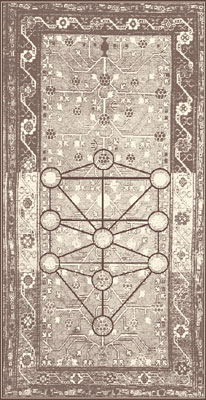 |
Tree of Spheres diagram
in a Pomegranate carpet |
After having lost the paradise of Eden, mankind has no further direct access to the Tree of Life, the path leading to the Tree is guarded by a pair of Cherubim, two Angels armed with flaming swords. This, however, does not mean that the path is entirely inaccessible. According to oral tradition, one of the two Cherubim has a male face and the other a female face. They represent the two basic polarities of existence, as they are expressed at the higher planes of consciousness. As these two principles gradually approach each other and become re-united, the angels cease being "Guardians of the Threshold"with the task of repelling anyone who is not entitled to enter and instead turn into the pillars supporting the gate leading back to the Garden of Eden. Their very presence acts as an indication and a point of reference for those seeking to return Home. According to other traditions, two trees, specifically two palm trees, define the arch standing above the gate of entry to the garden of Eden: the Fiftieth Gate of Knowledge, "the Gate of the Lord, through which the just proceed".
The design of the pomegranate in carpets echoes the spatial arrangement of the Sephirot tree and the diagram of Jacob's Ladder. (2) According to these simple figurative analogies, pomegranates are equivalent to the Sephirot.
In actual fact, in meditation exercises an individual sefirah could be recognized in a number of different ways. (3) In the Tiqqunim it is stated that the Sephirot of eternity and glory are called the two pomegranates. (4)
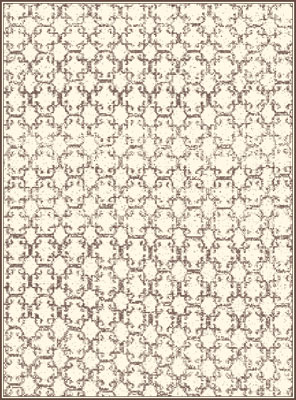 |
Lattice carpet,
(detail) |
Everything is bound to everything, down to the last link of the chain; and the real being of God is also both above and below, in heaven and on earth, and nothing exists outside of Him… Consider this fact and you will understand that the true existence of God is bound to all the worlds and that all the forms of existence are bound to each other and involved in each other, but that all proceed from His real existence.
from Séfer ha-rimmon, The Book of the Pomegranate by Moses de Leon de Granada, 1287.
In Jewish mysticism there is no separation between worlds, where the whole of creation, visible and invisible, is viewed as a great mesh which connects all entities, particularly by means of words and their endless combinations. From a kabbalistic standpoint, the most common representation of this conception - writes Scholem - is to be found in the Hebrew writings of Moses de Leon. He loves to present this thought by using the simile of the chain and the individual links which compose it. In this chain, the parts of which represent the worlds from top to bottom, there are links of differing degrees, some deeply hidden and others externally visible; but none of them truly has a separate existence. (5) The image of the chain in carpets stands as a further abstraction of the same idea, namely the contiguity and continuity of all worlds on which the light of creation shines.
When God gave the Torah to Israel, He opened the seven heavens for them, and they saw that in reality there was nothing but His glory; He opened the seven earths for them and they saw that there was nothing but His glory; He opened the seven abysses for them, and they saw that there was nothing but his Glory.
from Séfer ha-rimmon,The Book of the Pomegranate by Moses de Leon de Granada, 1287.
In the spiritual structure of creation there are passages, gates through which heaven and earth come into contact.
In carpets with the arch motif, numerical symbolism resonates with the symbolism of the gates. Seven arches repeating the same motif, one pomegranate tree which springs from a vase.
From earliest times, the organization of knowledge was based on numerical systems. The most widespread model was the planetary one, which was derived from the sub-division of heaven into seven spheres. An incredible number of connections could be established between man and numbers and sensible things so as to devise complex systems of meaning such as, for example, astrology. The symbolic dynamics is also present in Jewish mysticism with the specificities of its tradition. To summarize, the number seven describes the stages of a path and indicates the gates which the mystic must cross in order to progressively elevate his knowledge.
In the early centuries of the common era, in certain treatises of wisdom, the mystical union with the divine sphere is described in terms of a journey and a passage by the spirit of the mystic through seven successive stages of cognitive enlightenment. (6)
An ancient Babylonian tradition imagined the journey the soul is called upon to make as being littered with obstacles. In order to keep hostile angels at bay the soul needs a kind of pass, a magic seal. Circles, flowers, labyrinths and many other figures depicted in carpets are endowed with the same symbolic function. (7)
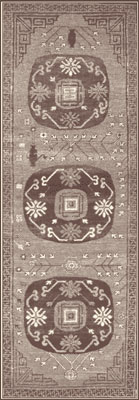 |
Three circles carpet,
(detail) |
In carpets with the circle motif, the representation of the pomegranate is generally from one of two points of view: either the view from above of a sphere with the crown opening at the centre or as a six-pointed star, or otherwise as a section of the fruit split in half so as to show the abundance of seeds in its interior.
The circle is linked to the original perception of the world as a potential birth of the elements which are still in a state of equilibrium among themselves. This is therefore a cosmogony where the most powerful metaphor is that of the seed or of the egg, as in the Greek mythical cycle of Phanes. (8) It is surprising to note the degree of similarity between the circle with pomegranate seeds found in carpets and the representations of the birth of the universe in certain mural 17th Century paintings in Rajasthan. (9)
In the past, astronomy and astrology coincided and the heavens, to put it very succinctly, always indicated the world above, the seat of the divinity, the origin and destination of man's soul. (10)
It is not coincidental that the circle design in carpets was identified with the moon, so much so that it was called the moon motif. (11) In the 6th Century Talmud, the moon as the planet of life's rhythms was identified with the human soul and this analogy between the circle, the moon and the soul is an invitation to call the pomegranate carpets also and specially the carpets of the soul.
In the Zohar a distinction is made between the various souls of man, which are: nefesh, life; ruach, spirit; neshama, soul. When a just person dies, the three parts of his soul split apart: neshama immediately enters the eternity of joy, ruach enters the garden of Eden, where it dons the body it had in life and, nefesh remains inside the earth where it finally finds repose and peace.
This simple tripartite division leads to a complex mystical speculation. The three circles in the carpet also allude to the elementary triad of air, water and fire and the three paths of the Kabbalah: gematrià, notariqòn and temurà.
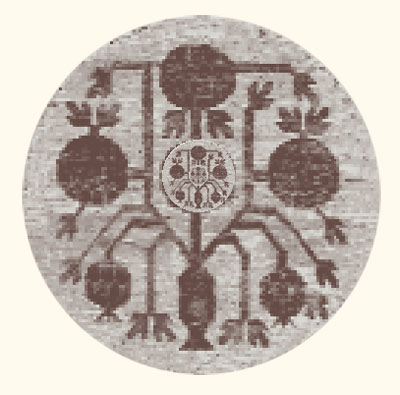 |
In some carpets the main circles are pomegranates which contain within themselves other pomegranates. This introduces the idea of worlds without end, one inside the other, ad infinitum, as in the spatial paradoxes of certain modern non-Euclidean geometries, which also describe the conditions of invisible realities. Such re-iterations are present in the kabbalistic tradition as a powerful suggestion operating for the purposes of meditation.
Each sefirah can at times enclose a mosaic of the twelve sephirot which in turn constitute it, and it is only the limit of graphical representation which prevents the reader's eyes being confronted by the vertigo of infinite worlds.
The mystery of the number ten (ten sephirot containing ten sephirot which contain ten more and so on) progressively projects mystic meditation into the most concealed part of being. The multiplication of the segments of reality is in actual fact what allows one to set off along the road of knowledge in a journey of freedom.
This process of unveiling reality corresponds to the process of unveiling the meaning of the Torah. (12)
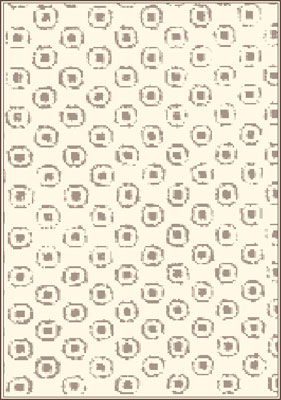 |
Pomegranate seeds carpet,
(detail) |
The pomegranate is one of the symbols in the Torah for the analogy between the seeds it contains and the 613 precepts of the Book.
The multiplication of the seed grains in the carpet's field is not only a clear allusion to prosperity and fecundity, but also a development of the idea of creation which, from being in the potential state in the circle, is enacted in space by expanding.
The numerous seeds of the pomegranate also signify the Torah in that each of its words has six hundred thousand faces, layers of meaning or points of entry, one for each of the children of Israel who stood at the foot of Mount Sinai. Each face is directed towards one of them, to whom it is visible and who can decipher it. Each man has his own unique and irreplaceable possibility of access to revelation. Authority no longer lies in the single and unchangeable meaning of divine communication, but in its boundless flexibility. (13)
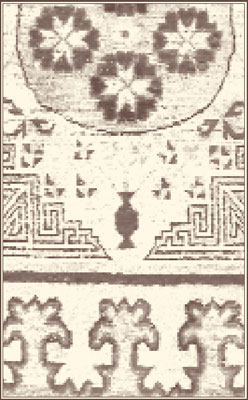 |
Carpet with vase motif,
(detail) |
The vase holding the pomegranate tree in carpets represents the complex idea of the development of creation.
The vase possesses a meaning of great importance in the kabbalistic tradition particularly because of the teachings of Yitzchaq Luria, the master of Safed.
In his mystical cosmogony, vases collect the divine energy, imagined to resemble a light which descends by successive contractions. The contraction called tzimtzum, consists in an adaptation of the light to ever smaller dimensions so as to be able to pour itself into ever smaller vases. The light then escapes from them, breaking them. This is the condition which allows organic nature to germinate and to come into being. (14)
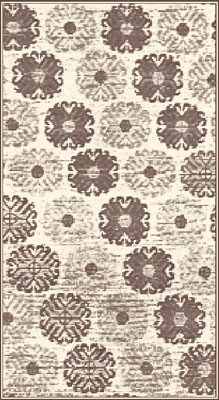 |
Carpet with cross section of flower,
(detail) |
The cross sections of flowers arranged into several lines in the carpet's field, might allude to another concept expressed by Luria, which holds that each individual soul exists as such until it accomplishes its spiritual re-generation. Souls which have kept the 613 precepts are released from the law of transmigration and joyfully await their inclusion into the original soul. Otherwise souls are subjected to transmigration, which may even be into other kingdoms of nature. In order to escape from this exile, Luria expounds the doctrine of "secret affinity and consequent sympathy between souls": some souls are in a relation to each other and there are even families of souls which make up a dynamic unit and who depend on each other. These souls have the special faculty of being able to provide each other with mutual help and to supplement each other with their actions. Through devout deeds, they are capable of summoning upwards sparks of their family which may have fallen into inferior existences and to ease their rise to higher forms of existence. (15)
References
(1) The Jewish word sefirah, pl. Sephirot, which during the Middle Ages was attributed the meaning of sphere and astral body, was made to relate to the spherical form of the pomegranate. The kabbalists were aware of the affinity between the Sephirot and the astronomers' spheres, and used the diagram of celestial orbits to enrich the symbolism of the Sephirot. G. Busi, Simboli del pensiero ebraico, Torino,1999, p.328. The link between sefirah and pomegranate is also to be found in an Arab tradition where it is said that the tree was planted by the Prophet himself. One of the terms for pomegranate is thus safiria, the Traveller. According to another tradition, Ibn Al- Awwam tells us, the pomegranate was introduced to Spain from Baghdad or Medina by a person called Sapher who was the first to grow it in Cordoba. Livre de l'agriculture, trad. J. J. Clément Mulet, Paris, 1864/186.
(2) Another figure which is symbolically equivalent is the Menorah. This touches on one of the most important aspects of Hebrew art: abstraction. The object becomes a vessel of spiritual light and its goal is to receive and transmit. Nadine Shenkar, L'arte ebraica e la cabala, Milano 2000, p.39. The small three-point marks which are found on carpets are similar to the letter sin, whose three arms are the three branches of the tree of life. G. Busi, op. cit.,1995, p.LXV.
(3) A sefirah could at the same time be a day of creation, a biblical character, an animal, a colour, a robe, an hour of the day, a letter of the alphabet, a cardinal point or a place; and the intimate understanding of this multiple nature was considered to be the only way to experience the refraction into creation of a single level of divine energy. G. Busi, op. cit., 1999, p.330.
(4) Pardes Rimmonim by Moses de Cordovero, cit. in Busi, 1999, p.596.
(5) G.Scholem, Le grandi correnti della mistica ebraica, Torino 1993, pag.232.
(6) Alfonso Di Nola, Cabala e mistica giudaica, Roma 1984, pp.22/23.
(7) G. Sholem, op. cit., 1993, pp.58/60.
(8) According to the Orphics it is he who revealed himself, Phanes was the name they attributed to Eros, who was born from a silver egg. After emerging from the egg, he was supposed to have set the universe in motion.
(9) The representation, which dates from the 17th Century and is of probable Hindu origin, differs only because of the presence of an outer circle. Ubaldo Nicola, Antologia illustrata di filosofia, Firenze, 2002, p.15.
(10) In the Kabbalah, the signs of the zodiac symbolize the powers of meditation between an inaccessible deity and the natural world. N. Shenkar, op.cit., p.86.
(11) Hans Bidder, Carpets from Eastern Turkestan, New York 1964, p.53.
(12) Giulio Busi, Elena Lowenthal, edited by, Mistica ebraica, testi della tradizione segreta del giudaismo dal III al XVIII secolo, Torino, 1995, p.LXVII.
(13) G. Sholem, La Kabbalah e il suo simbolismo, Torino 1980, p.18.
(14) G. Busi, op.cit., p.396. The figure of the vase is also present in the traditional repertory of figures in alchemical work; it symbolises the place where transformations, conceived as stages, of the original materia occur.
(15) G.Scholem, op.cit., 1993, pp.289/290.
|
